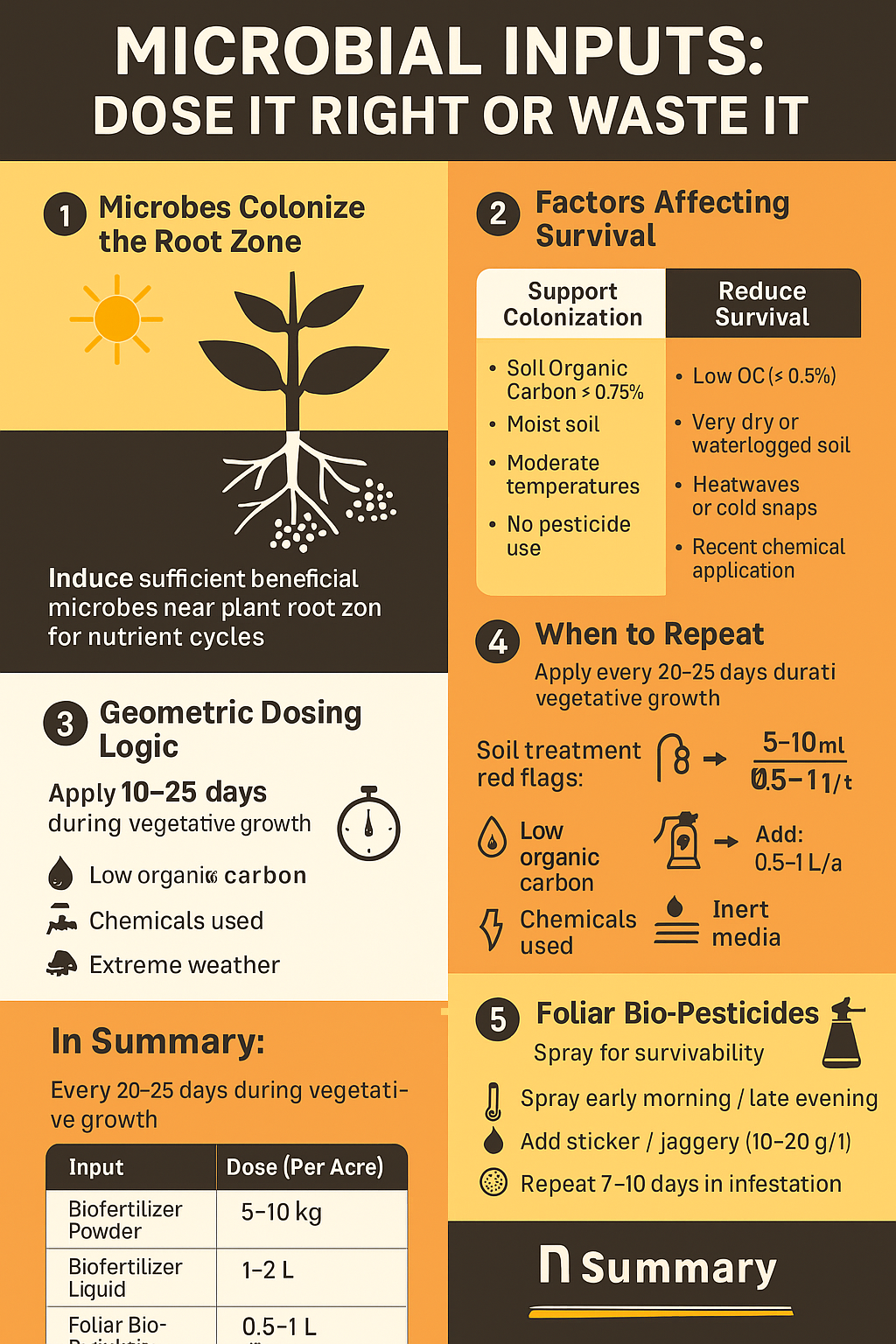
And yet again, another farmer blames the microbes.
But here’s the real reason: they weren’t given a fighting chance.
This blog explains:
Why dose matters (and how to calculate it)
What it takes for microbes to colonize your soil
When to repeat and why
How to dose foliar bio-pesticides
The goal of any biofertilizer is simple:
Get enough beneficial microbes near the plant root zone so they can multiply, establish, and influence nutrient cycles.
To do that, they must colonize a portion of the rhizosphere (the narrow region around the roots).
But here’s the problem:
Your soil already contains millions of other microbes, many of them aggressive and territorial. It’s like trying to get a few tourists to settle down in a packed city with local gangs.
| Support Colonization | Reduce Survival / Colonization |
|---|---|
| Soil Organic Carbon > 0.75% | Low OC (< 0.5%) – microbes starve |
| Moist soil (not waterlogged) | Very dry or waterlogged soil |
| Moderate temperatures | Heatwaves or cold snaps |
| No pesticide/fungicide use | Recent chemical application |
| Proper tillage / mixing | Broadcasting without incorporation |
Also note:
Trichoderma in a lab may dominate, but in soil it faces competition, predation, environmental stress—just like every other organism.
The soil environment moderates antagonism. So, a little overlap in microbial functions isn’t a sin—real-world survival sorts it out.
Let’s assume:
A powder biofertilizer has 10⁷ CFU/g (10 million per gram)
You want at least 10¹² to 10¹³ CFU per acre for effective colonization
That means:
10⁶ grams (1,000,000 g) = 1 ton (impractical)
But in practice, 10–20 kg per acre is effective with proper carriers and timing
| Formulation Type | Strength | Recommended Dose |
|---|---|---|
| Powder (10⁷ CFU/g) | Carrier-based | 5–10 kg/acre per dose |
| Liquid (10⁸ CFU/ml) | Suspension | 1–2 L/acre per dose |
Mix with compost/vermicompost to provide food and protection
Apply near root zone or via drip for better root access
Microbes face environmental stress, predators, and competition. Most won’t last more than 15–25 days unless they multiply successfully. So we need to help them in phases.
Every 20–25 days during vegetative growth
3–4 times per crop cycle
Apply after irrigation or light rain, when soil is moist
Low organic carbon (<0.5%)
Soil treated recently with chemicals
High tillage and exposed soil
Drought, heatwaves, cold snaps
Soilless or inert media (cocopeat, hydroponics, etc.)
In these cases, reduce the interval to 15 days or less
Leaves are tough terrain. Sunlight, dryness, and UV radiation kill microbes fast. So for foliar sprays, the logic changes.
Apply 10⁹ CFU per liter of spray to ensure pest interaction before UV kills the microbes.
Use 5–10 ml/liter of water
Spray 100–200 liters per acre
Total = 500 ml to 1 liter/acre
Stickers / spreaders (neem soap, pongamia soap, silicon)
Jaggery (10–20 g/l) or protein bait for entomopathogens
Spray early morning or late evening to avoid UV death
Repeat every 7–10 days during infestation period
No mixing with chemical sprays 2–3 days before/after
The lazy “1 kg per acre” label isn’t science. It’s compromise.
Always ask:
What’s the CFU/ml or CFU/g?
What’s the target population you need?
What’s the environment they’ll face?
They’re alive. They need:
Moisture
Organic food (carbon)
A safe entry into soil
Time to colonize
If you fail to give this, you’re not doing sustainable farming, you’re just playing expensive roulette with microbes.
| Input | Type | Dose (Per Acre) | Repeat |
|---|---|---|---|
| Biofertilizer | Powder (10⁷) | 5–10 kg | 20–25 days |
| Biofertilizer | Liquid (10⁸) | 1–2 L | 20–25 days |
| Foliar BioPesticide | Liquid (10⁸) | 0.5–1 L | 7–10 days |
Coming up in blog 3:
We dive into compatibility and antagonism — who can be mixed with whom, which microbes overpower others, and how this changes inside the soil.
There was this interesting discussion I had with Mr Prateek
The teaser of Self Running Soil Revolution for an investment
The effectiveness of any microbial product depends not just on
Mitrasena (Army of friends) is global brand of Biowall Agrihealth Pvt Ltd. Mitrasena products & protocols enables seamless transition to non-toxic farming by concurrently offering Excellent Protection, Higher Productivity & Profit and, Ease of use.
We are a DIPP recognized Startup working for non-toxic crop protection. We are driven by a highly passionate and professionally competent team.
MitraSena © 2025 | All rights reserved | Innovatively Designed and Built by Social Mukul Media
Have any query about bulk orders? Get in touch with us.